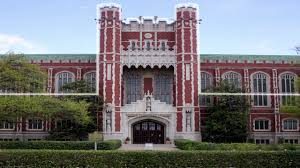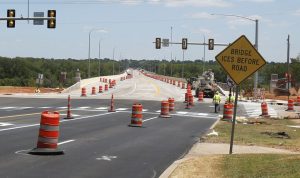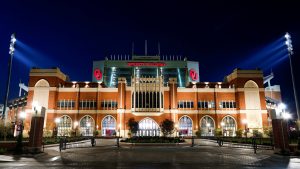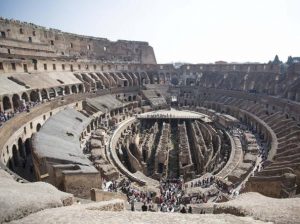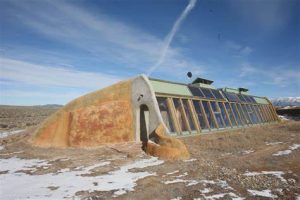
 As illustrated by this photo, living in a net zero home does not have to be extremely different than a traditional home. Tenants can easily live a normal lifestyle with tv and other modern amenities. Built in the dessert, the outside temperature can range from 100 degrees during the day to 50 degrees at night and the building manages to keep a constant indoor temperature of about 70 degrees without the use of a heater or air conditioner. The heating and cooling of his buildings comes from the earth itself. He often builds homes into a hill to provide a barrier from the harsh sun. As the first few feet of the soil absorbs heat, the next levels remain at fairly regulated temperature. This design allows for an inhospitable environment to become an ecofriendly safe haven.
As illustrated by this photo, living in a net zero home does not have to be extremely different than a traditional home. Tenants can easily live a normal lifestyle with tv and other modern amenities. Built in the dessert, the outside temperature can range from 100 degrees during the day to 50 degrees at night and the building manages to keep a constant indoor temperature of about 70 degrees without the use of a heater or air conditioner. The heating and cooling of his buildings comes from the earth itself. He often builds homes into a hill to provide a barrier from the harsh sun. As the first few feet of the soil absorbs heat, the next levels remain at fairly regulated temperature. This design allows for an inhospitable environment to become an ecofriendly safe haven.
All posts by James Cox
2.4 Michael Reynolds Pheonix, AR Earthship
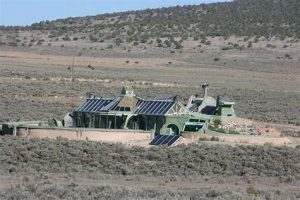
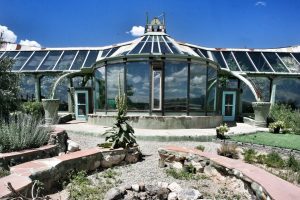
 Another location for Reynolds’s “Earthships” is near Phoenix, Arizona. Similar to many of the other buildings. It is built in a remote area where very few other architects would venture. However, Reynolds choses to rely on architecture to provide a livable environment rather than traditional natural resources, such as a river. Besides the thermal wrap of being built against a hill, this is partially due to the use of the sealed glass bottles in the wall. Since there is no air flow, dead air space cannot heat up or cool down. This is similar to the design of new coolers and cups such as Yeti.
Another location for Reynolds’s “Earthships” is near Phoenix, Arizona. Similar to many of the other buildings. It is built in a remote area where very few other architects would venture. However, Reynolds choses to rely on architecture to provide a livable environment rather than traditional natural resources, such as a river. Besides the thermal wrap of being built against a hill, this is partially due to the use of the sealed glass bottles in the wall. Since there is no air flow, dead air space cannot heat up or cool down. This is similar to the design of new coolers and cups such as Yeti.
2.2 Michael Reynolds Picuris,NM Earthship
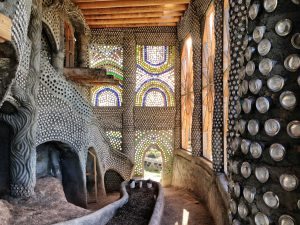 Reynolds uses similar ideas and models in each of his buildings. This building in New Mexico is also a net zero building. This means that the bills from a city or company is actually zero. The home is designed to clean rainwater for consumption. This allows for little to no need for a freshwater line from the city. It is also designed for waste management. Black water is treated by plants and is used for nutrients for plants for both clean air and food.
Reynolds uses similar ideas and models in each of his buildings. This building in New Mexico is also a net zero building. This means that the bills from a city or company is actually zero. The home is designed to clean rainwater for consumption. This allows for little to no need for a freshwater line from the city. It is also designed for waste management. Black water is treated by plants and is used for nutrients for plants for both clean air and food.
2.1 Michael Reynolds Buenos Aires
 Michael Reynolds is known for building net zero green buildings. He calls these buildings “Earthships.” His largest project at this time is this building he has constructed in Argentina. This structure is very different from his most common designs. He has traditionally built homes around New Mexico and Arizona, but instead this is actually a school. Each building is made from 100% sustainable material and a solar power energy source. Inside of many of the exterior wall of this building are glass bottles. This not only turns trash into a material, but also generates natural light to the house, much like traditional stained glass. He also uses used tires to create a retaining wall and many of the supports for the building. Lastly, he used many aluminum (soda) cans along with mortar to create many of the pillars the school contains for both aesthetic and structural quality. This is the first sustainable school in Argentina.
Michael Reynolds is known for building net zero green buildings. He calls these buildings “Earthships.” His largest project at this time is this building he has constructed in Argentina. This structure is very different from his most common designs. He has traditionally built homes around New Mexico and Arizona, but instead this is actually a school. Each building is made from 100% sustainable material and a solar power energy source. Inside of many of the exterior wall of this building are glass bottles. This not only turns trash into a material, but also generates natural light to the house, much like traditional stained glass. He also uses used tires to create a retaining wall and many of the supports for the building. Lastly, he used many aluminum (soda) cans along with mortar to create many of the pillars the school contains for both aesthetic and structural quality. This is the first sustainable school in Argentina.
Blog 1.4 (Bizzell Library)
The Bizzell Library on OU’s campus was the meeting spot for my friends and I several times throughout my freshman year. The library has a very open feel that can allow for loud collaboration on group projects, silent studying by yourself, or even just a place to relax. As you walked through the side entrance by the clock tower, the first thing you see is a model of the leaning tower of Pisa. As you pass, most students take a quick left and begin to head downstairs, but just beyond the stairs was our spot. This was because we originally went there to look at the university’s old yearbooks. As RUF/NEKS, we pride ourselves on knowledge of the University. We are a group that has been around for 104 years. This means that a lot of our history is entwined with that of the university’s. So, what better place to learn about OU’s history than the library. As the year went on, we continued to meet there between classes, to do homework, or just to hang out.
Blog 1.3 (James C. Nance Memorial Bridge)
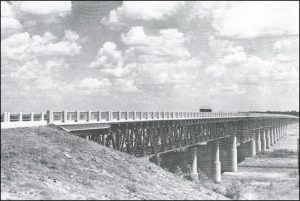 The James C. Nance Memorial Bridge runs between the two local towns of Purcell and Lexington. This bridge is part of U.S. 77 and crosses over the South Canadian river. It was originally built in 1938, making it one of the oldest bridges in Oklahoma. However, due to welding issues, the metal beams began to crack in recent years. The short-term solution was to place support brackets around the welds, but the bridge still needed to be replaced.
The James C. Nance Memorial Bridge runs between the two local towns of Purcell and Lexington. This bridge is part of U.S. 77 and crosses over the South Canadian river. It was originally built in 1938, making it one of the oldest bridges in Oklahoma. However, due to welding issues, the metal beams began to crack in recent years. The short-term solution was to place support brackets around the welds, but the bridge still needed to be replaced.
Being raised in Purcell, I have a little more personal attachment to this bridge than most. Like OU’s Red River Rivalry with Texas, we also battled Lexington for “ownership” of the bridge. Our team mascot is a dragon, while theirs is a bulldog, but what makes this even more similar to OU is that we are red, and they are orange. This being said, the bridge was under construction for the majority of my high school career.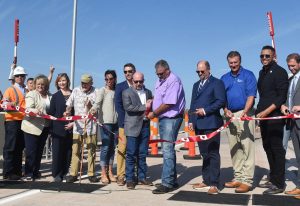 However, this summer the new bridge was officially opened. The coolest part was that my dad got to cut the ribbon alongside the mayor of Lexington. To make it better, he worked with OU to get the RUF/NEKS there to shoot our ceremonial shotguns. The goal was that I would be standing beside him as the ribbon was cut, but unfortunately, I was stuck in Paris due to issues with the plane. Luckily, other RUF/NEKS were able to be there.
However, this summer the new bridge was officially opened. The coolest part was that my dad got to cut the ribbon alongside the mayor of Lexington. To make it better, he worked with OU to get the RUF/NEKS there to shoot our ceremonial shotguns. The goal was that I would be standing beside him as the ribbon was cut, but unfortunately, I was stuck in Paris due to issues with the plane. Luckily, other RUF/NEKS were able to be there.
Blog 1.2 (Oklahoma Memorial Stadium)
The stadium here at the University of Oklahoma has a special place in my heart. Since my freshman year, I have spent countless hours both inside the building and on Owen Field. I am there nearly every day to study or work on homework. Actually, it is where I am currently writing this blog. This stadium is a big part of nearly every students’ college career. Whether it’s just because of the freshman class photo, walking by on the way to class, or going to the Saturday football games; the stadium is a part of OU life. Personally, I love that the stadium can bring people together. Each game can hold roughly 87,000 people in the stands, making it the most congested space in Oklahoma. On those Saturdays, the thousands become one. Whether it’s the roar of the crowd on third downs or the singing of the OU chant, the people become the beating heart of Oklahoma pride.
Blog 1.1 (Colosseo a Roma)
Last Summer I had the opportunity to go to Europe. Our first stop on the backpacking adventure was Rome, simply because we did not want to take any chances on missing an opportunity to see the Colosseum. Everything went perfect. We were lucky enough for a couple to cancel their tickets the night before we went on tour, so we got to skip all of the lines for the same price as everyone else. Once inside, many people would just see the warn down surface, but I have been in awe of this statement in history for years. The models and stories of what it once looked like were incredible. However, I did not know as much about the Colosseum as I had thought. Not only was this a place for gladiator fights, executions, and even a naval battle reenactment; but after all those years, it was still a staple to the environment. The Colosseum became home for hundreds of merchants and farmers in its later years. As I walked around, the building came to life. After many fires and constant modifications by locals, every little piece of ruin has a story.
